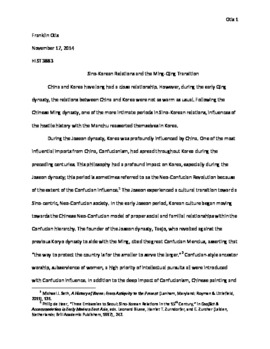| dc.contributor.author | Otis, Franklin | en_US |
| dc.contributor.editor | Capps, Sarah | en_US |
| dc.contributor.editor | Collins, Adriana | en_US |
| dc.contributor.editor | Dixon, Arthur | en_US |
| dc.contributor.editor | McCullough, Morgan | en_US |
| dc.contributor.editor | Miles, Sarah | en_US |
| dc.contributor.editor | Robertson, Terrence | en_US |
| dc.contributor.editor | Rodríguez, Monique | en_US |
| dc.contributor.editor | Romines, Richard | en_US |
| dc.contributor.editor | Scheller, Austin | en_US |
| dc.date.accessioned | 2016-11-15T21:55:31Z | |
| dc.date.accessioned | 2021-04-14T15:13:12Z | |
| dc.date.available | 2016-11-15T21:55:31Z | |
| dc.date.available | 2021-04-14T15:13:12Z | |
| dc.date.issued | 2015-04-01 | en_US |
| dc.identifier.uri | https://hdl.handle.net/11244.46/1226 | |
| dc.description | Shorter Works | en_US |
| dc.description.abstract | China and Korea have long had a close relationship. However, during the early Qing dynasty, the relations between China and Korea were not as warm as usual. Following the Chinese Ming dynasty, one of the more intimate periods in Sino-Korean relations, influences of the hostile history with the Manchu reasserted themselves in Korea. | en_US |
| dc.description.uri | http://history.ou.edu/journal-2015 | en_US |
| dc.relation.ispartofseries | OU historical journal ; 4 (Spring 2015) | en_US |
| dc.title | Sino-Korean Relations and the Ming-Qing Transition | en_US |
| dc.contributor.sponsor | Folsom, Raphael | en_US |
| dc.contributor.sponsor | Griswold, Robert | en_US |
| dc.contributor.sponsor | Olberding, Garret | en_US |
| dc.description.undergraduate | undergraduate | |
